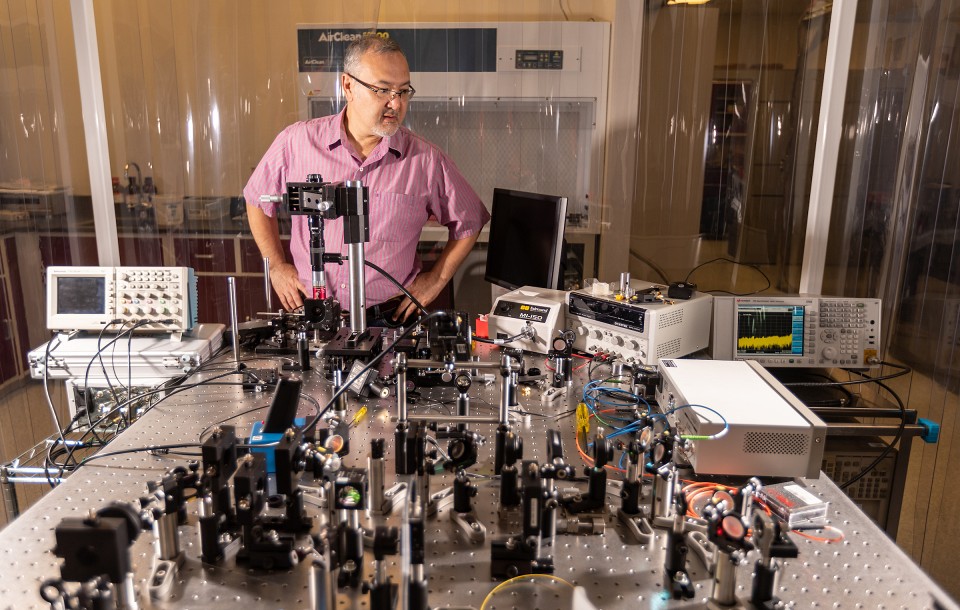By News and Internal Communications
By Karen Villarreal
RIO GRANDE VALLEY, TEXAS – In a quiet, specially designed lab on UTRGV’s Brownsville Campus, researchers prepare for the arrival of Raith’s Pioneer-2.
The first instrument of its kind in the South Texas region and one of few in Texas, it combines electron beam lithography (e-beam or EBL) functionality and scanning electron microscopy (SEM) capability.
And if that sounds complicated – it’s because it is.
Made possible by a $600,000 grant administered by the Army Research Office, under the Office of the Under Secretary of Defense for Research and Engineering, UTRGV now will have its own high-quality equipment with which to fabricate quantum chips. (The Army Research Office is part of the U.S. Army Combat Capabilities Development Command’s Army Research Laboratory.)
The instrument will drastically enhance UTRGV’s research capabilities and create new opportunities for students as they help refine the next generation of computers: those whose chips are not just “micro,” but “quantum.”
Dr. Malik Rakhmanov, associate professor in the UTRGV Department of Physics and Astronomy, said this grant eliminates the need for him and his students to travel 350 miles to the nearest similarly equipped facility at the University of Houston’s Nanofab Lab to carry out research.
INSIDE RAKHMANOV’S CLEAN LAB
Like other equipment used for this research, the Pioneer-2 is very delicate and requires a near-sterile environment to maintain accuracy. The air in the Rakhmanov Clean Lab – designed to Rakhmanov’s own specifications to uphold the high standards of cleanliness needed for the precision optics technologies – is filtered, enclosed by floor-to-ceiling overlapping clear plastic panels to create a controlled space free of dust and particles.
To illustrate the level of cleanliness, he runs his hand over the surface of a metal pegboard table onto which various glass and metal instruments are bolted.
“We haven’t had to dust these tables since they were first installed more than 10 years ago,” Rakhmanov said. “The Pioneer-2 will be housed in a similar clean space once it arrives.”
GOING QUANTUM
Some of the experiments in optical resonators conducted by Rakhmanov and his students in Brownsville’s Clean Lab are related to gravitational-wave physics, and contributed to the international LIGO Scientific Collaboration (LSC) that helped track and record gravitational waves.
But the DoD is interested in the lab for totally different research. The goal here is to prepare Rakhmanov and his physics students to carry out next generation optics research as it applies to quantum computing.
It sounds like science fiction, but essentially, Rakhmanov and other scientists in his field are using light at the nanoscale to more efficiently move data in computers.
The field is currently at an early stage, though.
“You can’t just put a quantum computer chip into a regular computer and it becomes a quantum computer,” he said. “The whole concept is different. It’s like comparing the abacus to the calculator.”
Quantum computing research combines hard-core physics (quantum mechanics), new technologies that control single atoms, and new computer algorithms into one powerful tool that, ultimately, allows for more efficient super-computer processing of very large quantities of data, Rakhmanov said.
“It could open the door for new research discoveries not limited to the fields of Artificial Intelligence (machine learning), cyber security and predictive modeling,” he said.
To handle more data, computers need more processing power – and they produce more heat, which must also be managed. Rakhmanov’s research essentially contributes to this cooling aspect by introducing photons into computing chips.
‘COOL’ TECHNOLOGY
Like all data processors, super-computers heat up from the friction generated as electrons move at higher and higher frequencies. New innovations in microchip technology use optical devices that do not generate friction or heat with photonic technology already found in the interconnects between some large data processing systems, Rakhmanov said.
But he predicts that, in future, the technology will be applied to the interior of the servers’ processors, not just the interconnects.
One of the main building blocks of silicon nanophotonics are micro-ring resonators, the focus of Rakhmanov’s current research.
“They can be used as optical filters, modulators for data processing and as logical circuits (switches) for emerging quantum computing technology,” he said.
MICROSCOPIC MICRO-RING RESONATOR MANUFACTURING AT UTRGV
Participating in the new wave of research, Rakhmanov and his students designed, built and characterized on-chip devices in which waveguides deliver light to micro-ring resonators.
The opportunity to work on a project of this magnitude builds Rakhmanov and his students’ capacity for precision lab work and nano-technology, which will only grow in demand as we enter the next century of computing, he said.
“I am very excited to work with my students on Quantum Computation and Information Technologies, and to see how our young university transforms the Valley,” Rakhmanov said.
ABOUT UTRGV
The University of Texas Rio Grande Valley (UTRGV) was created by the Texas Legislature in 2013 as the first major public university of the 21st century in Texas. This transformative initiative provided the opportunity to expand educational opportunities in the Rio Grande Valley, including a new School of Medicine and a School of Podiatry, and made it possible for residents of the region to benefit from the Permanent University Fund – a public endowment contributing support to the University of Texas System and other institutions.
UTRGV has campuses and off-campus research and teaching sites throughout the Rio Grande Valley including Brownsville (formerly The University of Texas at Brownsville campus), Edinburg (formerly The University of Texas-Pan American campus), Harlingen, Weslaco, McAllen, Port Isabel, Rio Grande City and South Padre Island. UTRGV, a comprehensive academic institution, enrolled its first class in the fall of 2015; the School of Medicine welcomed its first class in the summer of 2016, and the School of Podiatric Medicine in the fall of 2022.

